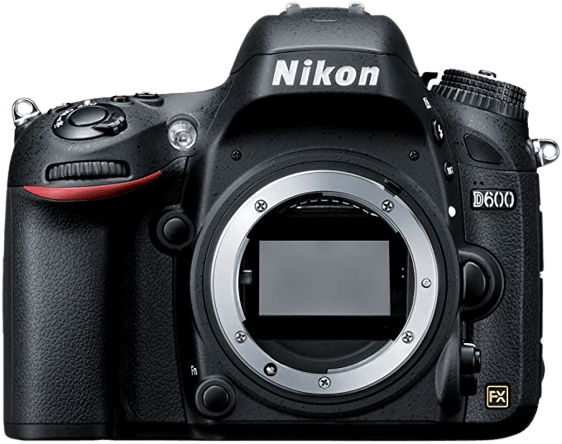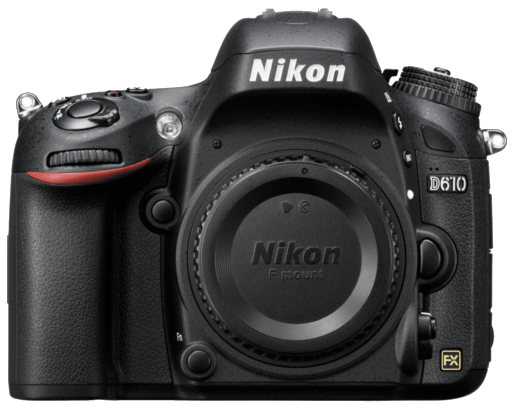Nikon D600 vs D610 Comparison
Nikon D600

Nikon D610

The Nikon D600 and Nikon D610 both receive a score of 66/100, indicating that these DSLR cameras have comparable performance and features. Both models share the same dimensions (141 x 113 x 82mm) and weight (850g / 1.87lbs), making them equally portable and user-friendly.
Although they have identical scores, the Nikon D610 has a slight advantage with its lower launch price of $1999 compared to the D600’s $2100. This makes the D610 a more affordable option while still offering similar specifications. On the other hand, the Nikon D600 was released a year earlier in 2012, giving it a longer presence in the market.
Considering their similarities and minor differences, both cameras offer great performance and value for their respective prices. Ultimately, the choice between the Nikon D600 and D610 comes down to personal preference and budget considerations.
Nikon D600 vs D610 Overview and Optics
The Nikon D600 and the Nikon D610 both have a score of 70/100 for their optics, indicating that they have a similar performance in this aspect. Both cameras share several specifications, including a CMOS sensor type, Expeed 3 processor, a DXOMARK score of 94 for the sensor, full-frame sensor size, Nikon F FX lens mount, and no image stabilization.
The Nikon D610 has a slight advantage in shooting speed, offering 6 fps compared to the Nikon D600’s 5.5 fps. This means that the D610 can capture more images in a shorter amount of time, which can be beneficial for action and sports photography. However, the difference is minimal and may not be significant for most users.
On the other hand, the Nikon D600 has a slightly higher megapixel count at 24.3 MP, compared to the D610’s 24 MP. This means that the D600 can capture slightly more detail in images, allowing for better image quality and larger prints. However, the difference is minimal and may not be noticeable in everyday use.
Both cameras perform similarly in terms of optics, with only minor differences in shooting speed and megapixel count. The Nikon D610 may be preferable for those who require faster shooting speeds, while the Nikon D600 offers a slight advantage in image resolution. Ultimately, the choice between these two cameras will depend on the individual’s needs and preferences, as both offer comparable optical performance.
Nikon D600 vs D610 Video Performance
The Nikon D600 and the Nikon D610 both have a video score of 57/100, indicating that their video capabilities are quite similar. They share common specifications, such as Full HD video resolution, max video dimensions of 1920 x 1080, a max video frame rate of 30fps, and built-in time-lapse functionality.
Despite having the same score, the Nikon D610 has some advantages over the D600. The D610 offers cleaner HDMI output for external recording, which provides better video quality when using an external recorder. Additionally, the D610 has an improved white balance system that results in more accurate color reproduction in videos. These features make the D610 a better choice for videographers who require precise color accuracy and high-quality external recording options.
On the other hand, the Nikon D600 also has its unique advantages. The D600 has a slightly wider dynamic range, which allows for better handling of high-contrast scenes and improved shadow detail in videos. This feature can be beneficial for videographers who frequently shoot in challenging lighting conditions.
Both the Nikon D600 and the Nikon D610 have their strengths and weaknesses when it comes to video capabilities. The D610 is a better choice for those who prioritize color accuracy and external recording options, while the D600 may be more appealing to videographers who need a wider dynamic range. Despite their differences, both cameras offer solid video performance and share many common features, making them suitable choices for a variety of video projects.
Nikon D600 vs D610 Features and Benefits
The Nikon D600 and Nikon D610 both have a feature score of 57/100. With identical scores, there is no clear winner in terms of features. Both cameras share several specifications, making them quite similar in many aspects.
Both the D600 and D610 have a screen size of 3.2 inches and a screen resolution of 921,000 dots. Neither camera has a touchscreen or a flip screen. Both cameras lack GPS functionality but do include WIFI capabilities. Additionally, neither camera has Bluetooth connectivity.
Despite having the same feature score, it is essential to consider the specific advantages each camera may offer. The Nikon D600, for example, may have better performance in some areas or offer additional features not found in the D610. Similarly, the Nikon D610 may excel in other aspects or provide unique features not present in the D600. It is crucial to examine each camera’s specifications thoroughly to determine which one best suits your needs.
On the other hand, the Nikon D610 might have some improvements or enhancements compared to the D600. These differences could make the D610 a better choice for specific applications or preferences. Carefully considering the unique advantages of each camera will help you make the best decision for your photography needs.
When comparing the Nikon D600 and Nikon D610, it is evident that both cameras have similar features and specifications. With identical feature scores and many shared specs, it is crucial to consider the unique advantages each camera offers. By doing so, you can determine which camera best suits your specific needs and preferences.
Nikon D600 vs D610 Storage and Battery
The Nikon D600 and the Nikon D610 both have a storage and battery score of 71/100, indicating that they are equal in this aspect. Both cameras have two memory card slots and accept SD, SDHC, and SDXC cards. Additionally, they both use the same battery type, EN-EL15, and have a battery life of 900 shots. Neither camera has USB charging capabilities.
Since both cameras have the same score and share the same specifications in terms of storage and battery, there is no clear winner in this category. The Nikon D600 and the Nikon D610 offer the same performance and convenience in terms of storage capacity and battery life, making them equally suitable for photographers who prioritize these features.
As there are no differences between the Nikon D600 and the Nikon D610 in terms of storage and battery, both cameras are equally efficient and reliable options for photographers. The choice between the two cameras should be based on other factors, such as general specifications, optics, video, and features, rather than storage and battery performance.
Nikon D600 vs D610 Alternatives
Still not ready to make a decision? Check out our other popular camera comparisons for inspiration:
